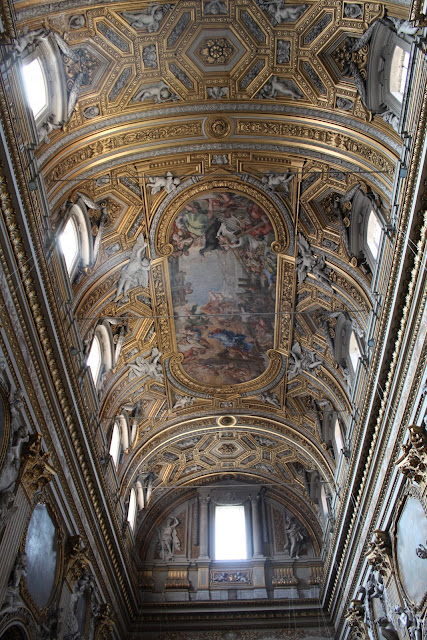Santa Maria sopra Minerva. Similar to Venice this church has a varied collection of paintings, sculpture and tombs from various centuries. However, it is different, and more typical of Rome, with it's more unified decorative program. Though unlike many of the major churches in Rome this one has a rather unexciting and heavy handed 19th century interior. The light that floods through the windows makes it beautiful nonetheless, and it also contains an array of beautiful works of art.
An impressive space, even if the 19th century blue and gold ceiling always strikes me as a bit silly.
I practiced capturing light and shade on some chairs.
Statue of Pope Urban VII in the Cappella dell'Annunziata Pope for 13 days in 1590.
Statue of St John the Baptist, the sculpture itself is not particularly stunning, but when the lights hits it the effect is quite dramatic.
And again from below.
Michelangelo's 'Christ bearing the cross' 1519.
Santa Maria in Valicella, or the Chiesa Nuova. The church was built for the Congregation of the Oratorians, which was founded by San Filippo Neri in 1551. Neri is one of my favourite saints, he used to make rich men who wished to join the congregation do something humiliating before they were allowed to enter, such as walk through Rome dressed only in rags. He was also Goethe's favourite saint and in his Italian Journey he described Neri as 'The Humorous Saint". The church contains some beautiful paintings including several by Federico Barocci, which Neri apparently used to swoon in front of. It was dark in the church but here are a few photos of one of the Barocci paintings.
Barocci, 'The Visitation', 1583-6.
Hello Donkey! Barocci's colours are truly amazing. It is always a little sad that many of his finest paintings are in chapels and therefore not very well lit. At the same time if you take the time to wait for them to emerge from the darkness and observe the way the candlelight or reflected sunlight pick out certain details you perhaps a more engaging experience and something closer to the original sixteenth century one that you would in a brightly lit gallery.
Always a favourite, San Carlo alle Quattro Fontane. I absolutely fell in love with the architecture of Borromini when I first visited Rome. It is almost impossible to photograph the architecture the way you want to, but at the same time the photos you do take are usually immensely engaging with the play of straight and curved forms banging against the strict square border of the photo. What you do miss is following the way that the architectural elements flow into one another.
These last photos are from the sacristy of Santa Maria Maddelena, near the Pantheon. The decoration dates from 1738-1741. It is a sumptuous space with playful illusionistic frescoes and rich rococo furnishings that have been painted to imitate marble and are framed by asymmetrical scrolls.
'Fake' windows painted to match the real windows opposite.
The ceiling is by Girolamo Pesci. The figures are rather large and slightly heavy in comparison to the very skillfully rendered architecture. One expects to see figures more in the style of Tiepolo, but perhaps it was necessary to imbue the space with a certain amount of gravitas and seriousness and devote appropriate space to the Virgin and other religious figures.



















No comments:
Post a Comment